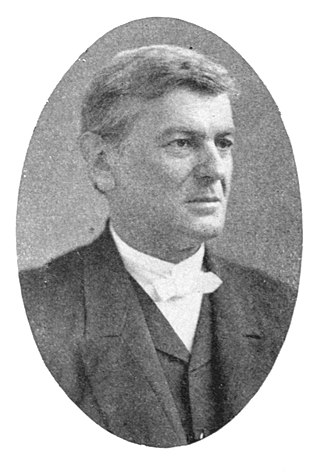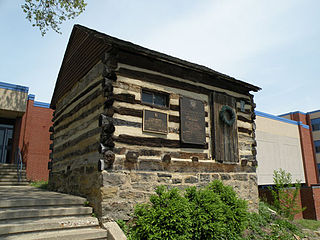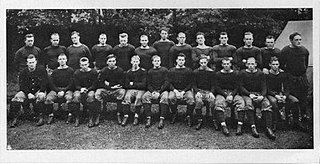Related Research Articles

Wilbur Francis "Pete" Henry was an American football player, coach, and athletic administrator. He was a charter inductee into both the College Football Hall of Fame in 1951 and the Pro Football Hall of Fame in 1963.

Sol S. Metzger was an American football player, coach of football and basketball, college athletics administrator, and sports journalist. He served as the head football coach at Baylor University (1904), the University of Pennsylvania (1908), Oregon State University (1909), West Virginia University (1914–1915), Washington & Jefferson College (1916–1917), Union College (1919), the University of South Carolina (1920–1924). Metzger was also the head basketball coach at South Carolina for one season in 1920–21, tallying a mark of 7–11. In addition, Metzger wrote a nationally syndicated sports column.

Robert Cook Folwell Jr. was an American football player and coach. He served as the head coach at Lafayette College (1909–1911), Washington & Jefferson College (1912–1915), the University of Pennsylvania (1916–1919), and the United States Naval Academy (1920–1924), compiling a career college football record of 106–29–9. Folwell then moved to the professional ranks, coaching the New York Giants of the National Football League (NFL) in 1925, the Philadelphia Quakers of the American Football League in 1926, and the Atlantic City Roses of the Eastern League of Professional Football in 1927.

Malcolm David "Red" Fleming was an American college football player and coach. Fleming attended Washington & Jefferson College in Washington, Pennsylvania, where he played football as a halfback from 1912 to 1914 for head coach Bob Folwell. Fleming was the 15th head football coach at the Virginia Military Institute (VMI) in Lexington, Virginia, serving the 1919 season and compiling a record of 6–2.

Frederick William Hinitt was an American Presbyterian pastor and academic administrator who was president of Parsons College, Central University of Kentucky, and Washington & Jefferson College for various periods between 1900 and 1918. He was educated at Westminster College, McCormick Theological Seminary, and the University of Wooster, and he began his career in the ministry at Presbyterian churches in Warrensburg, Missouri, and Ottumwa, Iowa. Already a member of the board of trustees of Parsons College, in Fairfield, Iowa, he was elected president of that school in July 1900. In spite of a fire that destroyed one of the school's few buildings, a new women's dormitory was constructed and funds were raised to build a Carnegie library.

William E. Slemmons was a prominent 19th century clergyman and academic in Western Pennsylvania.
The 1914 College Football All-America team is composed of college football players who were selected as All-Americans for the 1914 college football season. The only selectors for the 1914 season who have been recognized as "official" by the National Collegiate Athletic Association (NCAA) are Walter Camp, whose selections were published in Collier's Weekly, and the International News Service (INS), a newswire founded by William Randolph Hearst.

The Washington & Jefferson Presidents football team represents Washington & Jefferson College in collegiate level football. The team competes in NCAA Division III and is affiliated with the Presidents' Athletic Conference (PAC). Since its founding in 1890, the team has played their home games at College Field, which was remodeled and renamed Cameron Stadium in 2001.
The 1915 College Football All-America team is composed of college football players who were selected as All-Americans for the 1915 college football season. The only selectors for the 1915 season who have been recognized as "official" by the National Collegiate Athletic Association (NCAA) are Walter Camp, whose selections were published in Collier's Weekly, and the International News Service (INS), a newswire founded by William Randolph Hearst.

Joseph Ruggles Wilson Sr. was a prominent American Presbyterian theologian and father of President Woodrow Wilson, Nashville Banner editor Joseph Ruggles Wilson Jr., and Anne E. Wilson Howe. In 1861, as pastor of First Presbyterian Church in Augusta, Georgia, he organized the General Assembly of the newly formed Presbyterian Church in the United States, known as the Southern Presbyterian Church, and served as its clerk for 37 years.

Albert Hayes Sharpe was an All-American football player, coach and athletic director and medical doctor. He played football for Yale University and was selected as a halfback for the 1899 College Football All-America Team. Sharpe was also a star basketball player in the early years of the college game. Sharpe also excelled in baseball, gymnastics, rowing and track. In 1915, Sharpe was selected by one sporting expert as the greatest living athlete in the United States. He later served as a coach and administrator at Cornell University, Yale, the Ithaca School of Physical Education and Washington University in St. Louis.

The history of Washington & Jefferson College begins with three log cabin colleges established by three frontier clergymen in the 1780s: John McMillan, Thaddeus Dod, and Joseph Smith. The three men, all graduates from the College of New Jersey, came to present-day Washington County to plant churches and spread Presbyterianism to what was then the American frontier beyond the Appalachian Mountains. John McMillan, the most prominent of the three founders because of his strong personality and longevity, came to the area in 1775 and built his log cabin college in 1780 near his church in Chartiers. Thaddeus Dod, known as a keen scholar, built his log cabin college in Lower Ten Mile in 1781. Joseph Smith taught classical studies in his college, called "The Study" at Buffalo.

Robert Martin "Mother" Murphy was an administrator at Washington & Jefferson College; his efforts to improve the Washington & Jefferson Presidents football team directly led to its development as a national powerhouse during the early 20th century.

Charles Clinton Beatty was a Presbyterian minister, seminary founder, and academic philanthropist.
Britain Paterson (1888–1936), sometimes spelled Brit Patterson and Britton Patterson, was an American football player and coach. He played college football at Washington & Jefferson College in Washington, Pennsylvania. Patterson served as the head football coach at North Carolina College of Agriculture and Mechanic Arts—now North Carolina State University—in 1916, Waynesburg College—now known as Waynesburg University—in Waynesburg, Pennsylvania in 1924, and Manhattan College in 1927.

The 1914 Washington & Jefferson Red and Black football team was an American football team that represented Washington & Jefferson College as an independent during the 1914 college football season. Led by third-year head Bob Folwell, Washington & Jefferson compiled a record of 10–1.

The 1913 Pittsburgh Panthers football team was an American football team that represented the University of Pittsburgh as an independent during the 1913 college football season. In its first season under head coach Joseph Duff, the team compiled a 6–2–1 record and outscored all opponents by a total of 165 to 46.
The 1915 Washington & Jefferson Red and Black football team represented Washington & Jefferson College as an independent during the 1915 college football season. Led by Bob Folwell in his fourth and final year as head coach, Washington & Jefferson compiled a record of 8–1–1.
Leroy P. "Hank" Day was an American football coach. He served as the head football coach at Washington & Jefferson College in Washington, Pennsylvania from 1932 to 1936, compiling a record of 20–22–2. Day attended Washington & Jefferson and played college football in 1914 for head coach Bob Folwell. After graduating in 1915, he was the head football coach at Washington High School from 1916 to 1931. Day left Washington & Jefferson in 1937 and spent ten years as the head football coach at Farrell High School in Farrell, Pennsylvania. He returned to Washington High School as head football coach in 1947. After three more seasons at Washington High School, Day's contact was not renewed in the spring of 1950. He tallied records of 101–15–9 during his first stint at Washington High School, 49–28–7 at Farrell, and 3–23 in his final run at Washington. He was later a grade school principal.
The 1914 All-Eastern football team consists of American football players chosen by various selectors as the best players at each position among the Eastern colleges and universities during the 1914 college football season.
References
- ↑ Social Security Administration (2014). "Burleigh Cruikshank" . U.S., Social Security Death Index, 1935–2014 (database record) – via ancestry.com.
- 1 2 "Call Made to Pastor: Westminster Extends Invitation to Rev. Cruikshank, of Pittsburg, to Become Its Minister". Steubenville Herald Star. October 27, 1921.
- 1 2 3 4 5 E. Lee, North (1991). "Chapter 5: The Folwell Years.. Among Football's Best". Battling the Indians, Panthers, and Nittany Lions: The Story of Washington & Jefferson College's First Century of Football, 1890-1990. Daring Books. pp. 62–74. ISBN 978-1-878302-03-8. OCLC 24174022.
- ↑ "James P. Sinnot Puts Toohey on His All-American eleven". New Brunswick Times. December 1, 1914.
- ↑ Spalding's Official Football Guide 1915
- ↑ "W. & J. Athletes Among Leading Students in Graduating Class". The Charleroi Mail. June 12, 1915.
- 1 2 "Cruikshank May Take Folwell's Job: All-American Center of 1914 Probable Successor to Present W. & J. Football Coach". New Castle News. December 24, 1915.
- ↑ "Made Eleven Coaches: Folwell of W. & J. Produced That Many from One Squad" (PDF). The New York Times. June 20, 1916.
- 1 2 "All-American Football Star is Now a Preacher". Mansfield News. December 25, 1920.
- ↑ "Pittsburgh Church to Foster Athletics". Waterloo Evening Courier. December 16, 1920.
- ↑ "Personals". Steubenville Herald. December 22, 1921.
- ↑ "Social Events". Steubenville Herald Star. June 7, 1926.
- 1 2 "Unbeaten 1922 Team Honored at Banquet for H.S. Athletes". Steubenville Herald-Star. February 16, 1923.
- ↑ "Pastor Talks On Football". Chester Times. April 18, 1928.("The Rev. Burleigh Cruikshank, pastor of St. Paul's Presbyterian Church ... was the principal speaker at the annual men's night held at Swarthmore College last night. His subject was 'Football Coaches I Have Known.'")
- 1 2 3 "84 Graduates at Wash-Jeff Given Degrees: Rev. Burleigh Cruikshank Addresses Class at Commencement". The Pittsburgh Press. June 6, 1928.
- ↑ "Dinner To Open Club's Activities" (PDF). The Westfield Leader. October 26, 1932. Archived from the original (PDF) on August 11, 2011.
- ↑ "W. & J. Question in Mind: Dave Morrow Can Answer It". The Pittsburgh Press. January 21, 1946.
- ↑ "Social Security Death Index". Roots Web.